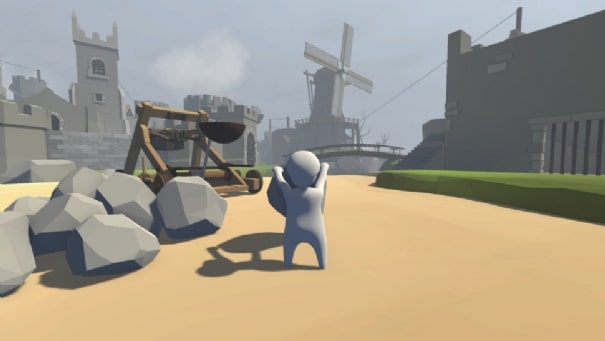Now the wizards know that dreaming of falling from great distances might be a synonym of insecurity, shame or guilt, but this is not the subject we want to talk about. What matters is, in fact, to understand what kind of experience gives the title during the eight playable levels, quickly faced in a matter of hours. For the benefit of those who did not use the PC version, we must say that the first feeling we experienced during the first moments was different from what one could expect; the title, in some ways, tries to give a very serious and vaguely didactic tone (and here is the comparison withThe Talos Principle), also thanks to a preponderant audio segment.
Bob, in the game, looks like a highly articulate white man, who can not count on any particular skill. He does not jump very high, he can not run, he does not have a high stature. All he can do is grab things, cling, and fall from high heights without getting hurt. By exploiting these elements, the player must be able to overcome the logical challenges of the various levels, which will offer puzzles that, to be solved, will have to be dealt with with a minimum of inventiveness.
Just like in I Am Bread and in Surgeon Simulator, the deliberately embarrassing movements of the protagonist – coupled with a well-established physical engine – mean that the main goal is not to think about what the right action to be done but how to do it. For example: on more than one occasion it will be clear that to go ahead you have to open a door, but practical needs take the lead: how to open it? Which path to choose to arrive nearby? And if it was not the only possible way? The two flaccid arms that moved walls and mountains
The meaning of the whole game seems to be the ability to overcome complicated puzzles without having to rely on special powers of some sort. The good thing is, however, that to do this you will need to use Bob’s not very agile body. The analysis of the control system can better explain this concept; the two triggers, then, allow you to move the character’s arms; this way you can hold objects, push, throw, and climb. With another button you can skip some hopping, while with another one another our joints will fall out, dropping (a kind of little-sized ragdoll that reminded us of Goat Simulator).
To be able to do all these actions, however, will be a great business, so it is true that the game will never be so prodigious with instructions and information, unless short initial tutorials are excluded. Being able to figure out how to pass a too high step will give some satisfaction, and we have to say that after the first initial tenths the gaming dynamics convinced us, and gave more than a satisfaction.
The game, then, encourages you never to take the shortest route: once you get into a heavy lever then why not try to see what happens if you throw it against a door? Or, once you know how to run a catapult, why not replace the boulder you want to throw and see what happens?
The Human World : Fall Flatallows you to answer all of these questions through a gameplay that is based on a solid physics, and that gives you a lot of freedom of action. For example, we had a door on a hill not reachable on foot. In our possession, only a large wooden slab. What to do? We tried to use the wooden deck piece by exploiting a nearby structure, but after several failures we turned the camera, noticing the bars. We tried thus to insert the wooden slab between two pylons that, obviously, with the right pressure loosened, leaving us room to continue.
This can be a good summary of what Human offers : Fall Flat: a puzzle game that forces the player to undergo a certain system of physics and clumsy movements that, if well-interpreted, can give more than one satisfaction. Of course, it must be said that the frustration will start to be felt as soon as the same action has been repeatedly tried again, punctually failing.
All of this is the result of Bob’s control and motion system, deliberately difficult to handle. In any case, these dynamics suggest that the best way to enjoy the game is that of short matches; the good positioning of the checkpoints of rescue, in fact, would seem to give more importance to this idea. We swing everything, but not with the smile on the lips

